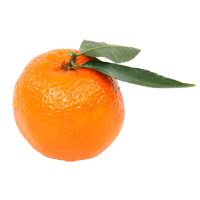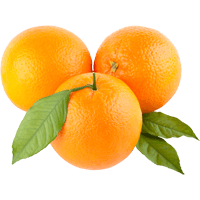Cuties Oranges Nutrition Vitamin C

vs

Introduction
Do you feel the coming of Christmas time with the ripening of clementines or you haven't ever noticed that? I am absolutely sure that their scent subconsciously has resembled you Christmas, since their ripening season is from November to February. On the other hand, you can find oranges almost all year round. Although clementine belongs to the orange family, orange is not Clementine. Clementine may seem as a tidy and petite orange at first sight, but they are different types of citruses. Clementine is smaller than orange, sweeter, and rounded with easy peeling thinner skin. Besides, it is worth mentioning, that clementine has sterility since it is a hybrid type, in other words, it is seedless.
In an effort to avoid any confusion, let's try to find out their differences and similarities.
Nutritional content comparison
From the very start it is necessary to point out that there are no significant differences between oranges and clementines in nutritional content, they have almost similar nutrition value. Both are good source of dietary fiber, orange is higher in Fiber. On the other side, clementine is lower in Cholesterol, Sugars and Saturated fat.
Vitamins comparison
As indicated in the charts of comparison below, in terms of vitamins orange is the winner. It is higher in Vitamin A, Vitamin B2, Vitamin B5, slightly higher in Vitamin C and Vitamin B1. Clementine, in addition, is considerably higher in Vitamin B3, and kind of higher in Vitamin B6 and Vitamin E.
Vitamins comparison
As indicated in the charts of comparison below, in terms of vitamins orange is the winner. It is higher in Vitamin A, Vitamin B2, Vitamin B5, slightly higher in Vitamin C and Vitamin B1. Clementine, in addition, is considerably higher in Vitamin B3, and kind of higher in Vitamin B6 and Vitamin E.
Minerals comparison
What about minerals? According to the data set out below, orange wins hands on again. It is higher in Calcium, Potassium, Copper and Zinc. At the same time, Clementine is higher in Iron and Phosphorus. Magnesium is equal in both.
Health benefits
One orange per day, higher in Fiber, can ensure 18% of the reference daily intake (1). Dietary fiber has many beneficial effects on health. First of all it improves our digestive health, contributes to the weight loss, and lowers cholesterol and sugar levels in the blood, decreasing by this way the risk of coronary heart diseases, hypertension, diabetes, stroke, obesity and several gastrointestinal illnesses (2).
Both orange and clementine, like most citruses, are rich sources of Vitamin C. Vitamin C, above all, prevents the pathological state named scurvy. Then, it has a strong antioxidant, anti-inflammatory, antiviral, antibacterial and immune-boosting properties (4). Due to its antioxidant properties, Vitamin C has also anticancer properties. According to the study (5), high levels of Vitamin C, equal to around 300 oranges, have impaired the growth of BRAF and KRAS mutant colorectal tumors. These tumors are considered to be the most aggressive types, and do not respond to chemotherapy in a proper way. Before passing to the next question I would like to dwell on the fact, that Vitamin C also prevents Iron deficiency anemia together with citric acid by increasing Iron absorption from the digestive tract.
Orange also has antioxidant properties owing to higher content of Vitamin A, and other antioxidants called flavonoids. An orange a day keeps macular degeneration away. According to the study (3) people who regularly eat oranges has a less risk of macular degeneration development, than those who do not it oranges. The exclusivity of this research is that they have linked the low risk of macular degeneration not only with Vitamins C, E and A, but also with flavanoids.
Conversely, clementines with higher Vitamins B6, B1 protect our heart; contribute to metabolism and the right function of nervous system. Clementines are also higher in Folic acid (Vitamin B9), which is essential for the right formation of germ cells, the brain of embryo, especially during the pregnancy's first trimester. Moreover, it protects our blood vessels from damage and formation of atherosclerotic plaques, which is a result of increased levels of homocysteine in a deficiency of folic acid.
Oranges richer in Calcium and Potassium contribute to bone and hearth health respectively. Potassium, as a crucial component of body cells and fluids, controls the blood pressure. In this connection it should be noted that oranges contain more citric acid and citrates, and in particular Potassium citrate is believed to prevent the formation of kidney stones (6).
On the top of everything else, owing to its rejuvenating and pain relieving features, Clementine oil is widely used in aromatherapy, ensure by this way restful sleep. You can get rid of stress, uplift the mood and get a mental clarity, thanks to the massage with Clementine oil.
Historical background
Oranges originated in either China or India, where they had named "Chinese apples". The first mention of them in ancient texts dates back to approximately to 2200 B.C. (7). The first orange had been brought to America in 1493 by Christopher Columbus.
Clementines were developed in Algeria in 1902 by French missionary Father Clement Rodier, and named after him. It is a hybrid between sweet orange and mandarin orange. In 1925 Corsicans started to cultivate it.
Conclusion
Thus, it follows logically from what has been said, that the difference in nutritional content comparison of oranges and clementines is insignificant. Orange is higher in fiber in macronutrients comparison, than Clementine. In vitamin and mineral comparisons orange is title-holder again with higher Vitamins A, B2, B5 and Calcium, Potassium, Copper and Zinc. Both of them have great health impact. The final choice depends on your individual preferences.

Profession: Medical biochemistry MD
Last updated: November 29, 2020
Infographic

Mineral Comparison
Mineral comparison score is based on the number of minerals by which one or the other food is richer. The "coverage" chart below show how much of the daily needs can be covered by 300 grams of the food
![]()
2
:
5
![]()
Contains more Iron +40%
Contains more Phosphorus +50%
Contains more Calcium +33.3%
Contains more Zinc +16.7%
Contains less Sodium -100%
Equal in Potassium - 181
Equal in Magnesium - 10
Equal in Copper - 0.045
Contains more Iron +40%
Contains more Phosphorus +50%
Contains more Calcium +33.3%
Contains more Zinc +16.7%
Contains less Sodium -100%
Equal in Potassium - 181
Equal in Magnesium - 10
Equal in Copper - 0.045
Vitamin Comparison
Vitamin comparison score is based on the number of vitamins by which one or the other food is richer. The "coverage" chart below show how much of the daily needs can be covered by 300 grams of the food
![]()
3
:
7
![]()
Contains more Vitamin E +11.1%
Contains more Vitamin B3 +125.5%
Contains more Vitamin B6 +25%
Contains more Vitamin B2 +33.3%
Contains more Vitamin B5 +65.6%
Contains more Folate +25%
Equal in Vitamin C - 53.2
Equal in Vitamin E - 0.18
Equal in Vitamin B1 - 0.087
Contains more Vitamin E +11.1%
Contains more Vitamin B3 +125.5%
Contains more Vitamin B6 +25%
Contains more Vitamin B2 +33.3%
Contains more Vitamin B5 +65.6%
Contains more Folate +25%
Equal in Vitamin C - 53.2
Equal in Vitamin E - 0.18
Equal in Vitamin B1 - 0.087
Vitamin and Mineral Summary Scores
The summary score is calculated by summing up the daily values contained in 300 grams of the product. Obviously the more the food fulfills human daily needs, the more the summary score is.
Vitamin Summary Score
21
![]()
24
![]()
Mineral Summary Score
8
![]()
8
![]()
Macronutrients Comparison
Macronutrient comparison charts compare the amount of protein, total fats, and total carbohydrates in 300 grams of the food. The displayed values show how much of the daily needs can be covered by 300 grams of food.
Protein
5%
![]()
6%
![]()
Carbohydrates
12%
![]()
12%
![]()
Fats
1%
![]()
1%
![]()
Which food is preferable for your diet?
![]()
![]()
is better in case of low diet
 |  | |
| Low Calories diet | Equal | |
| Low Fats diet | | |
| Low Carbs diet | | |
| Low glycemic index diet | | |
People also compare
Comparison summary
Which food contains less Sodium?
![]()
Orange contains less Sodium (difference - 1mg)
Which food is lower in glycemic index?
![]()
Orange is lower in glycemic index (difference - 2)
Which food is richer in vitamins?
![]()
Orange is relatively richer in vitamins
Which food is lower in Cholesterol?
![]()
Clementine is lower in Cholesterol (difference - 0mg)
Which food is lower in Sugar?
![]()
Clementine is lower in Sugar (difference - 0.17g)
Which food is lower in Saturated Fat?
![]()
Clementine is lower in Saturated Fat (difference - 0.015g)
Which food is cheaper?
![]()
Clementine is cheaper (difference - $0.4)
Which food is richer in minerals?
?
It cannot be stated which food is richer in vitamins. See the charts below for detailed information. See the charts below for detailed information. See the charts below for detailed information.
Cuties Oranges Nutrition Vitamin C
Source: https://foodstruct.com/compare/clementines-raw-vs-oranges

0 komentar:
Posting Komentar